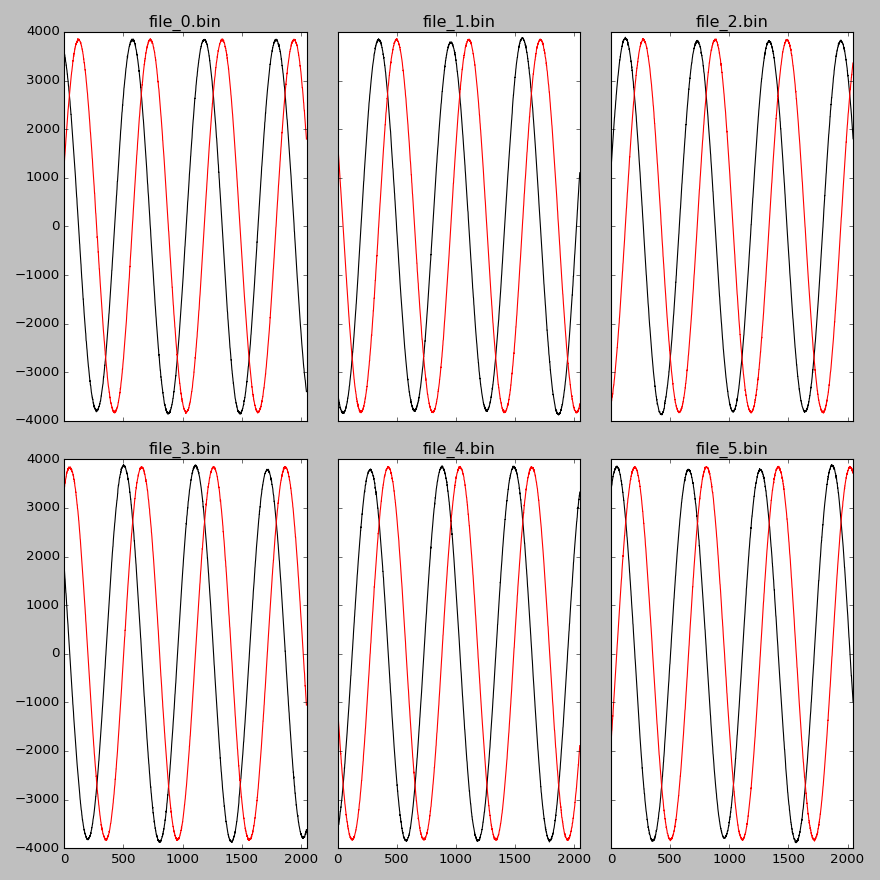Recording Signals with Python¶
We have received a few requests for a detailed tutorial on how to record signal data using the AIR-T. The Deepwave team does this regularly to record training data for our neural networks. It is convenient to record with the AIR-T because it can enable you to control equipment and label the data during the recording process.
We recommend connecting an external hard drive (preferably an SSD) to the USB 3.0 or SATA connection. The AIR-T's built in flash drive will quickly become full and could cause issues. Therefore we recommend not recording directly to the flash memory on the AIR-T.
Here is an example python script to interact directly with the AIR-T SoapySDR drivers. It is based off of the Receiving Samples with Python tutorial with a bit more code added for data recording and reading back the data files for plotting. When you execute it on the AIR-T, you should see the plot below. Note that in the following example, we injected a 2400.2 MHz sine wave into the system.
Python Code¶
#!/usr/bin/env python3
# Import Packages
import numpy as np
import os
from matplotlib import pyplot as plt
import SoapySDR
from SoapySDR import SOAPY_SDR_RX, SOAPY_SDR_CS16
########################################################################################
# Settings
########################################################################################
# Data transfer settings
rx_chan = 0 # RX1 = 0, RX2 = 1
N = 16384 # Number of complex samples per transfer
fs = 31.25e6 # Radio sample Rate
freq = 2.4e9 # LO tuning frequency in Hz
use_agc = True # Use or don't use the AGC
timeout_us = int(5e6)
# Recording Settings
cplx_samples_per_file = 2048 # Complex samples per file
nfiles = 6 # Number of files to record
rec_dir = '/media/deepwave/ssd' # Location of drive for recording
file_prefix = 'file' # File prefix for each file
########################################################################################
# Receive Signal
########################################################################################
# File calculations and checks
assert N % cplx_samples_per_file == 0, 'samples_per_file must be divisible by N'
files_per_buffer = int(N / cplx_samples_per_file)
real_samples_per_file = 2 * cplx_samples_per_file
# Initialize the AIR-T receiver using SoapyAIRT
sdr = SoapySDR.Device(dict(driver="SoapyAIRT")) # Create AIR-T instance
sdr.setSampleRate(SOAPY_SDR_RX, 0, fs) # Set sample rate
sdr.setGainMode(SOAPY_SDR_RX, 0, use_agc) # Set the gain mode
sdr.setFrequency(SOAPY_SDR_RX, 0, freq) # Tune the LO
# Create data buffer and start streaming samples to it
rx_buff = np.empty(2 * N, np.int16) # Create memory buffer for data stream
rx_stream = sdr.setupStream(SOAPY_SDR_RX, SOAPY_SDR_CS16, [rx_chan]) # Setup data stream
sdr.activateStream(rx_stream) # this turns the radio on
file_names = [] # Save the file names for plotting later. Remove if not plotting.
file_ctr = 0
while file_ctr < nfiles:
# Read the samples from the data buffer
sr = sdr.readStream(rx_stream, [rx_buff], N, timeoutUs=timeout_us)
# Make sure that the proper number of samples was read
rc = sr.ret
assert rc == N, 'Error Reading Samples from Device (error code = %d)!' % rc
# Write buffer to multiple files. Reshaping the rx_buffer allows for iteration
for file_data in rx_buff.reshape(files_per_buffer, real_samples_per_file):
# Define current file name
file_name = os.path.join(rec_dir, '{}_{}.bin'.format(file_prefix, file_ctr))
# Write signal to disk
file_data.tofile(file_name)
# Save file name for plotting later. Remove this if you are not going to plot.
file_names.append(file_name)
# Increment file write counter and see if we are done
file_ctr += 1
if file_ctr > nfiles:
break
# Stop streaming and close the connection to the radio
sdr.deactivateStream(rx_stream)
sdr.closeStream(rx_stream)
########################################################################################
# Plot Recorded Data
########################################################################################
nrow = 2
ncol = np.ceil(float(nfiles) / float(nrow)).astype(int)
fig, axs = plt.subplots(nrow, ncol, figsize=(11, 11), sharex=True, sharey=True)
for ax, file_name in zip(axs.flatten(), file_names):
# Read data from current file
s_interleaved = np.fromfile(file_name, dtype=np.int16)
# Convert interleaved shorts (received signal) to numpy.float32
s_real = s_interleaved[::2].astype(np.float32)
s_imag = s_interleaved[1::2].astype(np.float32)
# Plot time domain signals
ax.plot(s_real, 'k', label='I')
ax.plot(s_imag, 'r', label='Q')
ax.set_xlim([0, len(s_real)])
ax.set_title(os.path.basename(file_name))
plt.show()
Output Plot¶
